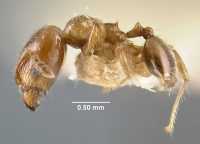Pheidole nitidicollis
| Pheidole nitidicollis | |
|---|---|

| |
| Scientific classification | |
| Kingdom: | Animalia |
| Phylum: | Arthropoda |
| Class: | Insecta |
| Order: | Hymenoptera |
| Family: | Formicidae |
| Subfamily: | Myrmicinae |
| Tribe: | Attini |
| Genus: | Pheidole |
| Species: | P. nitidicollis |
| Binomial name | |
| Pheidole nitidicollis Emery, 1896 | |
| Synonyms | |
| |
This species occurs in mature wet forest. It is a relatively common arboreal ant, nesting in dead branches and under epiphytes. Colonies often appear large, with workers scattered over a wide area (Longino 2009). The Ecuador series was collected from a rotten section of a live tree, about 1.5 m above ground in forest (Wilson, 2003).
Identification
See the description in the nomenclature section.
Keys including this Species
Distribution
Mexico to Costa Rica.
Latitudinal Distribution Pattern
Latitudinal Range: 19.331389° to 0.34689°.
| North Temperate |
North Subtropical |
Tropical | South Subtropical |
South Temperate |
- Source: AntMaps
Distribution based on Regional Taxon Lists
Neotropical Region: Belize, Brazil, Costa Rica (type locality), Ecuador, Guatemala, Honduras, Jamaica, Mexico (type locality), Nicaragua.
Distribution based on AntMaps
Distribution based on AntWeb specimens
Check data from AntWeb
Countries Occupied
| Number of countries occupied by this species based on AntWiki Regional Taxon Lists. In general, fewer countries occupied indicates a narrower range, while more countries indicates a more widespread species. |

|
Estimated Abundance
| Relative abundance based on number of AntMaps records per species (this species within the purple bar). Fewer records (to the left) indicates a less abundant/encountered species while more records (to the right) indicates more abundant/encountered species. |

|
Biology
Castes
Worker
Minor
Images from AntWeb
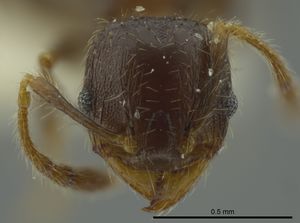  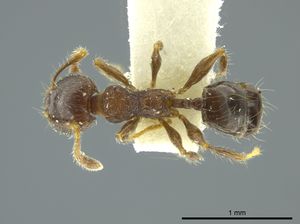 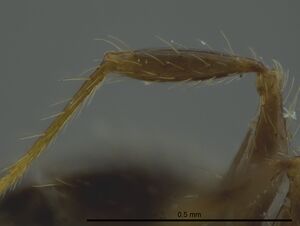 
| |
| Paratype Pheidole chalcoides. Worker. Specimen code casent0624252. Photographer Jeremy Pilllow, uploaded by University of Utah. | Owned by MCZC. |
Major
Images from AntWeb
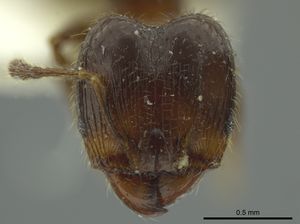  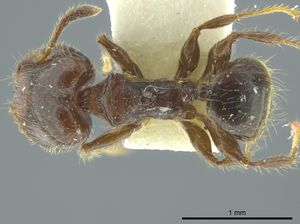  
| |
| Paratype Pheidole chalcoides. Worker (major/soldier). Specimen code jtlc000016346. Photographer Jeremy Pilllow, uploaded by University of Utah. | Owned by MCZC. |
Nomenclature
The following information is derived from Barry Bolton's Online Catalogue of the Ants of the World.
- nitidicollis. Pheidole dimidiata var. nitidicollis Emery, 1896g: 79 (s.w.) COSTA RICA.
- Subspecies of dimidiata: Emery, 1922e: 107.
- Status as species: Wilson, 2003: 474.
- Senior synonym of sagana: Longin, 2009: 58.
- Senior synonym of chalcoides: Longin, 2019: 51.
- sagana. Pheidole sagana Wheeler, W.M. 1934g: 169 (s.w.) MEXICO.
- Status as species: Wilson, 2003: 501.
- Junior synonym of nitidicollis: Longino, 2009: 58.
- chalcoides. Pheidole chalcoides Wilson, 2003: 397, figs. (s.w.) MEXICO.
- Junior synonym of nitidicollis: Longino, 2019: 51.
Unless otherwise noted the text for the remainder of this section is reported from the publication that includes the original description.
Description
From Wilson (2003): DIAGNOSIS A small, yellow member of the flavens group whose major has a prominent, rounded humerus that rises well above the mesonotum in dorsal-oblique view, a roughly semicircular outline of promesonotum in side view, and an oval postpetiolar node. Similar to tenerescens but with the major possessing a low mesonotal convexity present (in side view), longer cephalic carinulae, larger propodeal spine and spiracle, and with a brown as opposed to yellow gaster.
See also the less similar Pheidole arhuaca, Pheidole flavifrons, Pheidole minutula, other species listed as close to Pheidole arhuaca, and members of the “flavens complex” listed under flavens (q.v.).
MEASUREMENTS (mm) Lectotype major: HW 0.80, HL 0.84, SL 0.44, EL 0.10, PW 0.40. Minor (Nevis): HW 0.42, HL 0.44, SL 0.40, EL 0.06, PW 0.24.
COLOR Major and minor: yellow.
P. chalcoides
Medium-sized, bicolorous, similar to Pheidole chalca of Hidalgo and Veracruz, distinguished in the major by the rugoreticulate humerus, which is also more prominently extended in dorsal-oblique view; by the narrower and laterally rounded postpetiolar node, and by the light brown (as opposed to yellow) occiput; and in the minor by the toothed humerus and foveolate, opaque pronotal dorsum.
Also similar but less so to Pheidole arhuaca, Pheidole caulicola, Pheidole mincana, Pheidole sagana, Pheidole schmalzi, Pheidole tragica and Pheidole umphreyi, differing in details of body shape, sculpture (especially mesosomal), and color.
MEASUREMENTS (mm) Holotype major: HW 0.98, HL 1.00, SL 0.48, EL 0.12, PW 0.50. Paratype minor: HW 0.52, HL 0.56, SL 0.44, EL 0.08, PW 0.34.
COLOR Major: head weakly bicolorous, with anterior third of the capsule brownish yellow and the rear two-thirds light brown; mesosoma, waist, and appendages light to medium brown; gaster medium brown. Minor: head, mesosoma, waist medium brown; gaster dark brown; appendages light brown.
P. nitidicollis. Upper: lectotype, major. Lower: minor. Nevis, West Indies, col. Neal A. Weber, associated major compared with lectotype. Scale bars = 1 mm.
P. chalcoides. Upper: holotype, major. Lower: paratype, minor. Scale bars = 1 mm.
Type Material
Longino (2009):
Lectotype major worker (here designated, as labeled by Wilson 2003) and associated paralectotype minor worker: Costa Rica, Jiménez [a site near present day La Selva Biological Station] (Alfaro) Museo Civico di Storia Naturale, Genoa (not examined).
Pheidole sagana: Lectotype major worker (here designated, as labeled by Wilson 2003) and associated paralectotype minor worker: Mexico, Veracruz, Mirador (Skwarra) Museum of Comparative Zoology (examined).
Pheidole chalcoides: MEXICO: 3 km west of Fortin De Las Flores, Veracruz, 1000 m, col. R. J. Hamton and A. B. Hamton. Museum of Comparative Zoology
Etymology
L nitidicollis, shiny neck, referring evidently to the smooth rear of head. (Wilson 2003)
Pheidole chalcoides: Gr chalcoides, like chalca, a similar species.
References
- Emery, C. 1896g. Studi sulle formiche della fauna neotropica. XVII-XXV. Bull. Soc. Entomol. Ital. 28: 33-107 (page 79, soldier, worker described)
- Emery, C. 1922e. Quelques fourmis nouvelles minuscules. Ann. Hist.-Nat. Mus. Natl. Hung. 19: 107-112 (page 107, subspecies of dimidiata)
- Kempf, W. W. 1972b. Catálogo abreviado das formigas da região Neotropical. Stud. Entomol. 15: 3–344.
- Longino, J.T. 2009. Additions to the taxonomy of New World Pheidole. Zootaxa 2181: 1-90. PDF
- Wilson, E. O. 2003. Pheidole in the New World: A dominant, hyperdiverse ant genus. Harvard University Press, Cambridge, MA. (page 474, Raised to species: new status, fig. major, minor described)
References based on Global Ant Biodiversity Informatics
- Dattilo W. et al. 2019. MEXICO ANTS: incidence and abundance along the Nearctic-Neotropical interface. Ecology https://doi.org/10.1002/ecy.2944
- Fernández, F. and S. Sendoya. 2004. Lista de las hormigas neotropicales. Biota Colombiana Volume 5, Number 1.
- Forel A. 1912. Formicides néotropiques. Part III. 3me sous-famille Myrmicinae (suite). Genres Cremastogaster et Pheidole. Mémoires de la Société Entomologique de Belgique. 19: 211-237.
- Kempf, W.W. 1972. Catalago abreviado das formigas da regiao Neotropical (Hym. Formicidae) Studia Entomologica 15(1-4).
- Longino J. T. 2013. Ants of Nicargua. Consulted on 18 Jan 2013. https://sites.google.com/site/longinollama/reports/ants-of-nicaragua
- Longino J. T. 2019. Pheidole (Hymenoptera, Formicidae) of Middle American wet forest. Zootaxa 4599: 1-126
- Longino J. T. L., and M. G. Branstetter. 2018. The truncated bell: an enigmatic but pervasive elevational diversity pattern in Middle American ants. Ecography 41: 1-12.
- Longino J. et al. ADMAC project. Accessed on March 24th 2017 at https://sites.google.com/site/admacsite/
- Quiroz Robledo L. N., and J. E. Valenzuela Gonzalez. 1993. Contribucion al conocimiento de la mirmecofauna del estado de Hidalgo, Mexico (Hymenoptera: Formicidae). En: Villavicencio-Nieto (ed) Flora y Fauna del Estado de Hidalgo. Universidad Autónoma de Hidalgo. p. 340-393. ISBN 968-63 40-36-X
- Vásquez-Bolaños M. 2011. Lista de especies de hormigas (Hymenoptera: Formicidae) para México. Dugesiana 18: 95-133
- Wilson, E.O. 2003. Pheidole in the New World: A Dominant, Hyperdiverse Genus. Harvard University Press
